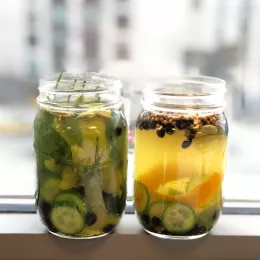Yogurt is an everyday refrigerator staple, something we buy at the grocery store without a second thought. But what if the next time you scraped the bottom of the yogurt cup, you didn’t have to run out to the store? What if you took that last spoonful of yogurt, mixed it into a few cups of milk, set it in a warm place for a few hours and forgot about it. Well, when you came back to check on it, it would have turned into yogurt, that’s what.
 The DIY craze is one home cooking trend I can really get behind, and homemade yogurt is one of the simplest DIY food projects you can attempt. What's more, you probably have everything you need to make yogurt in your house already: yogurt, milk, a jar and somewhere to keep it warm.
The DIY craze is one home cooking trend I can really get behind, and homemade yogurt is one of the simplest DIY food projects you can attempt. What's more, you probably have everything you need to make yogurt in your house already: yogurt, milk, a jar and somewhere to keep it warm.
The yogurt doesn’t have to be expensive (though an organic brand is ideal), just make sure to check the ingredient label to see that it contains “live and/or active cultures.” Specifically you’re looking for lactobacillus bulgaricus and streptococcus thermophilus. These are the "good" bacteria that turn regular ol’ milk into creamy, tangy yogurt. Some brands may also contain lactobacillus acidophilus, which is an added bonus, but not required. Next, you need milk. Again, organic is ideal, but any milk will do. Before setting the yogurt process in motion, you’ll want to heat the milk to 185˚F to make sure the only bacteria growing in your yogurt are the good guys. This step of heating also helps evaporate excess water, giving you a richer finished product.
Finally, you need a clean jar and somewhere warm to keep it. Glass mason jars are ideal because they are easy to fill and store—not to mention easy to clean. After a thorough washing, place the jars in a large pot of boiling water for 1 minute to sterilize. Remove with a pair of tongs and avoid touching the inside of the jar or anywhere near the opening.

Setting up a cozy little place for bacteria to grow can be high-tech (sous vide machine) or low-tech (an insulated cooler/styrofoam box). All you’re looking for is a steady environment of 104˚F to 117˚F, and a warm water bath is the ideal way to hold this temp.
See recipe below for more details.
I’ve been making yogurt at home in Sous Vide Supreme for some time now. It’s a great, compact solution that maintains exact temperature and perfectly fits one quart mason jars. With a consistently maintained temperate you can also “cook” yogurt for a longer time, which gives your yogurt with a bit more acidity or "tang", as some tasters found in our tests. In our ICE kitchen "lab", we also found that an insulated cooler (or even more simply, a styrofoam box with a tight fitting lid) is a suitable spot for yogurt making as well. In our tests, we found that the cooler lost heat at the rate of 1 degree/hour. Meaning that in the four hours our yogurt took to make, the temperature went from 119˚F to 115˚F. The results were delicious—decidedly more creamy than tart. Our tasters were split 50/50 on the Sous Vide yogurt (8 hours @ 104˚F) and the "cooler" yogurt (4 hours @ avg. 117˚F).

After discovering that the bacteria associated with acidity didn’t have enough time to fully develop within the shorter incubation time in the cooler, we tried a second test. This time, after 4 hours in the cooler, rather than chilling them immediately, we removed the jars from the water bath and let them sit for two hours at room temperature. The extra time gave us the small boost in acidity we were looking for. So, no matter which approach you take, your next batch of homemade yogurt is no more than a few hours away.
Ingredients
- 32 fl oz whole milk
- 2 tablespoons yogurt with live cultures
Directions
- Place the milk in a sauce pot over medium heat. Bring to 185˚F to kill any bacteria that may be present in the milk. Then cool the pot back to 120˚F.
- Whisk in 2 tablespoons of the yogurt with live cultures and transfer mixture to sterilized glass jar.
- Set up a water bath. If using a sous vide machine or other externally controlled bath, set temperature to 104˚F. Place the jars in the bath, uncovered and leave to "cook" for 8-10 hours. If using a cooler, heat water to 120-125˚F and pour into the cooler. Check the temperature of the water, if it has dropped below 119˚F take some of the water out and heat it again until the water temperature in the cooler is 119-120˚F. Place the jar containing yogurt mixture in the cooler and close the lid. Leave to "cook" 4 hours. Allow the mixture to stand an additional 2 hours at room temperature for a tangier result. (You can taste the milk mixture from the jar after initial 4 hours to decide what suits your tastebuds).
- To thicken your yogurt, gently transfer from the jar to a strainer lined with a coffee filter. Place in the refrigerator to drain a few hours to overnight. Transfer the strained yogurt to a clean container and keep refrigerated.



